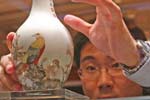Web Comments
China steps away from export-led growth
Updated: 2011-04-11 15:41
By Hua Xiuping (chinadaily.com.cn)
According to statistics released by the General Administration of Customs on 10 April, China's quarterly trade balance turned red from January to March this year, the country's first quarterly trade deficit in six years. Surging import volumes, readjusted RMB exchange rates and rising commodity prices are lying behind this trade deficit figure. China's exports increased 26.5 percent year on year, while imports soared 32.6 percent from a year earlier.
It may be a great relief to those caring about either global imbalances or domestic economic structures. It is more or less a signal that China now is trying to step away from an export-led economic growth model.
In the last three decades, China has followed an export-led economic development model adopted by East Asian newly industrialized countries and regions such as South Korea, Taiwan, Hong Kong and Singapore, which became known as the ‘four tigers’ by virtue of their rapid economic growth.
But why was it attractive to pursue the growth of external demand rather than stimulate demand at home?
The reasons are very easy to see. First, having strong links to high-income markets in the US and Europe is very important for economic growth in labour-intensive countries, working as sources of capital and know-how. Using best-practice global technology, one country can achieve faster productivity growth in the traded goods sector than one can by growing the supply of non-traded goods for sale to domestic consumers.
Secondly, in order to absorb surplus labour coming out of agriculture, the developing and emerging market countries such as 'four tigers' and China had to pursue an export-led growth strategy and maintain undervalued exchange rates to facilitate this.
Thirdly, noted by many economists, it is also working as a public sector strategy of 'self insurance' against future financial crises. The resulting surpluses of an export-led economic development model were intended for the building up of official reserves in a precautionary manner, to deal with outflows of domestic savings, and 'sudden stops' in capital inflows.
Without any doubt, for a country at their early economic development stage, it is a rational choice to adopt an export-led economic development model. That is exactly what has happened in many developing countries, in particular East Asian ones.
High-income markets were vital for growing labour-intensive manufactured exports or information technology and outsourced business process services in such countries. Abundant labour forces have also been absorbed by traded good sectors. Stockpiling of foreign exchange reserves in several East Asian countries has grown at a faster pace since the 1997 Asian financial crisis.
However, situations do change! Today, it is no more a rational choice to keep an export-led economic development model in China.
As many economists point out, despite its extraordinary growth performance during the past decades, distortions in China's economic structure are very striking. To maintain its export-oriented economy, domestic consumption has been severely constrained in China and non-traded goods and services are much under-developed. Even the top Chinese government officials such as Premier Wen admit that the existing growth pattern is unstable, unbalanced and unsustainable.
Specials

Share your China stories!
Foreign readers are invited to share your China stories.

Art auctions
China accounted for 33% of global fine art sales.

Waiting for drivers' seat
Lack of sponsorship appears to be why Chinese drivers have yet to race in a Formula 1 event